3. The Earth moves in an almost perfectly uniform circular orbit with the Sun at its center, 1.5 x 108 km away. A) What is the period of its orbit in seconds? [You should be able to figure this out from other facts you know without looking anything up] B) What is the frequency of this orbit in Hertz (Hz)? C) What is the angular frequency of this orbit in radians/second (rad/s)?
Simple harmonic motion
Simple harmonic motion is a type of periodic motion in which an object undergoes oscillatory motion. The restoring force exerted by the object exhibiting SHM is proportional to the displacement from the equilibrium position. The force is directed towards the mean position. We see many examples of SHM around us, common ones are the motion of a pendulum, spring and vibration of strings in musical instruments, and so on.
Simple Pendulum
A simple pendulum comprises a heavy mass (called bob) attached to one end of the weightless and flexible string.
Oscillation
In Physics, oscillation means a repetitive motion that happens in a variation with respect to time. There is usually a central value, where the object would be at rest. Additionally, there are two or more positions between which the repetitive motion takes place. In mathematics, oscillations can also be described as vibrations. The most common examples of oscillation that is seen in daily lives include the alternating current (AC) or the motion of a moving pendulum.
![3. The Earth moves in an almost perfectly uniform circular orbit with the Sun at its center,
1.5 x 108 km away.
A) What is the period of its orbit in seconds? [You should be able to figure this out from other
facts you know without looking anything up]
B) What is the frequency of this orbit in Hertz (Hz)?
C) What is the angular frequency of this orbit in radians/second (rad/s)?
D) What is the speed the Earth moves at around the sun in m/s?
E) What is the magnitude of the Earth's acceleration during its orbital motion in m/s²?
F) If you're on the Earth which direction does this acceleration point?](/v2/_next/image?url=https%3A%2F%2Fcontent.bartleby.com%2Fqna-images%2Fquestion%2F1fed7a52-65d8-44f4-988f-6c762cda0c09%2Fe43aa148-2e5c-4a3e-963f-d81f4f6b818a%2Fxw9sdeo_processed.jpeg&w=3840&q=75)

Step by step
Solved in 2 steps with 2 images









